AIM Project Management Practitioner BSBPMG512-518 Assessment Kit 2/4
VerifiedAdded on 2023/01/06
|37
|10090
|66
Homework Assignment
AI Summary
This document is a comprehensive assessment kit solution for the Project Management Practitioner course, specifically addressing units BSBPMG512, BSBPMG513, BSBPMG514, and BSBPMG518. The assessment covers key aspects of project management, including time, quality, cost, and procurement management. The solution includes answers to knowledge questions, which explore topics such as estimating project duration, identifying critical paths, managing project baselines and variances, and understanding project life cycle phases. Additionally, the document provides insights into various time management methodologies like Pareto Analysis, progress reporting, and variance analysis, along with techniques for project scheduling, such as project network diagramming, critical path analysis, and Gantt charts. The assessment also delves into the application of work breakdown structures in project schedules. This resource is designed to assist students in understanding and successfully completing their project management assessments, providing valuable examples and explanations to enhance their learning and application of project management principles.
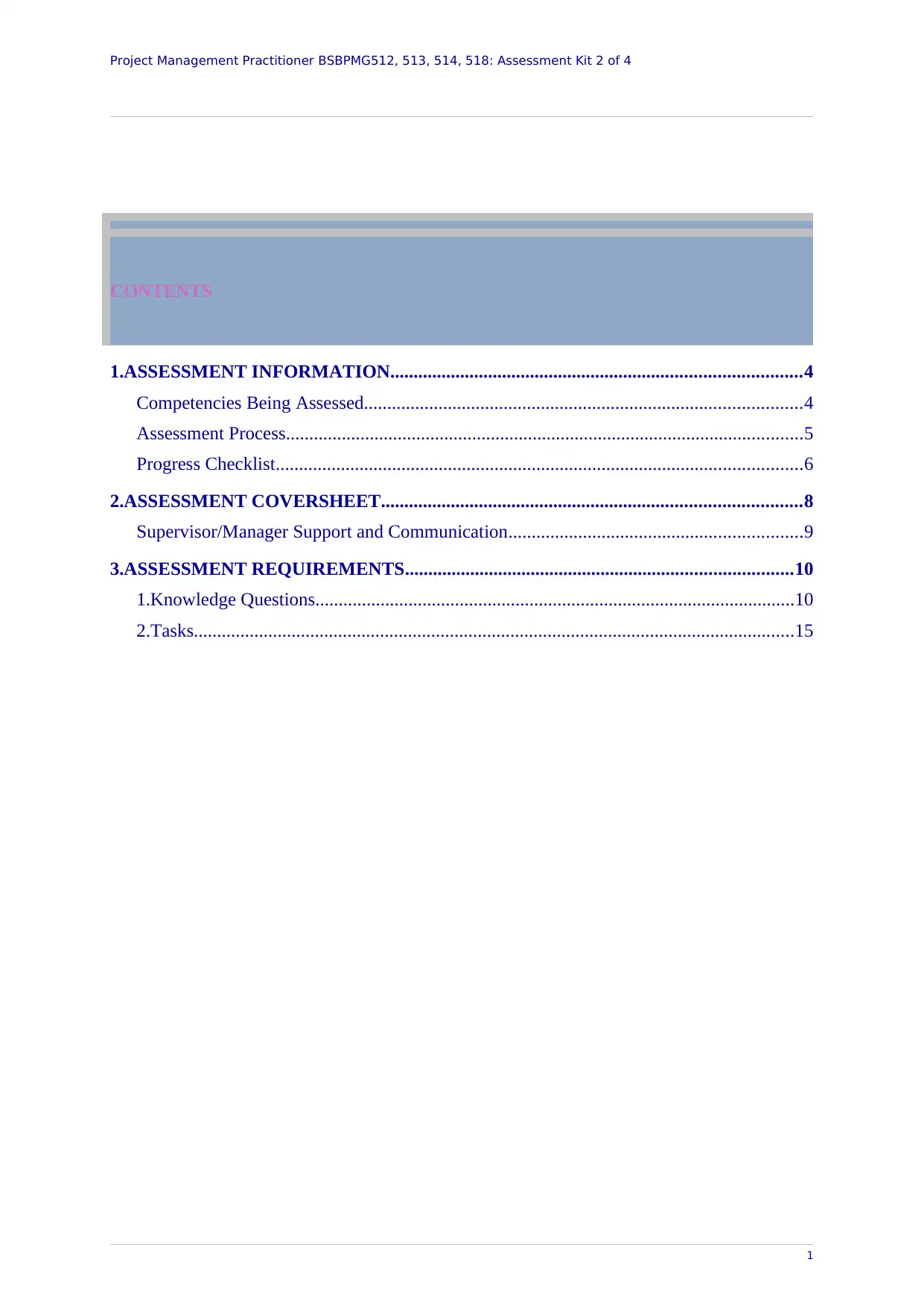
Project Management Practitioner BSBPMG512, 513, 514, 518: Assessment Kit 2 of 4
CONTENTS
1.ASSESSMENT INFORMATION........................................................................................4
Competencies Being Assessed..............................................................................................4
Assessment Process...............................................................................................................5
Progress Checklist.................................................................................................................6
2.ASSESSMENT COVERSHEET..........................................................................................8
Supervisor/Manager Support and Communication...............................................................9
3.ASSESSMENT REQUIREMENTS...................................................................................10
1.Knowledge Questions.......................................................................................................10
2.Tasks.................................................................................................................................15
1
CONTENTS
1.ASSESSMENT INFORMATION........................................................................................4
Competencies Being Assessed..............................................................................................4
Assessment Process...............................................................................................................5
Progress Checklist.................................................................................................................6
2.ASSESSMENT COVERSHEET..........................................................................................8
Supervisor/Manager Support and Communication...............................................................9
3.ASSESSMENT REQUIREMENTS...................................................................................10
1.Knowledge Questions.......................................................................................................10
2.Tasks.................................................................................................................................15
1
Paraphrase This Document
Need a fresh take? Get an instant paraphrase of this document with our AI Paraphraser
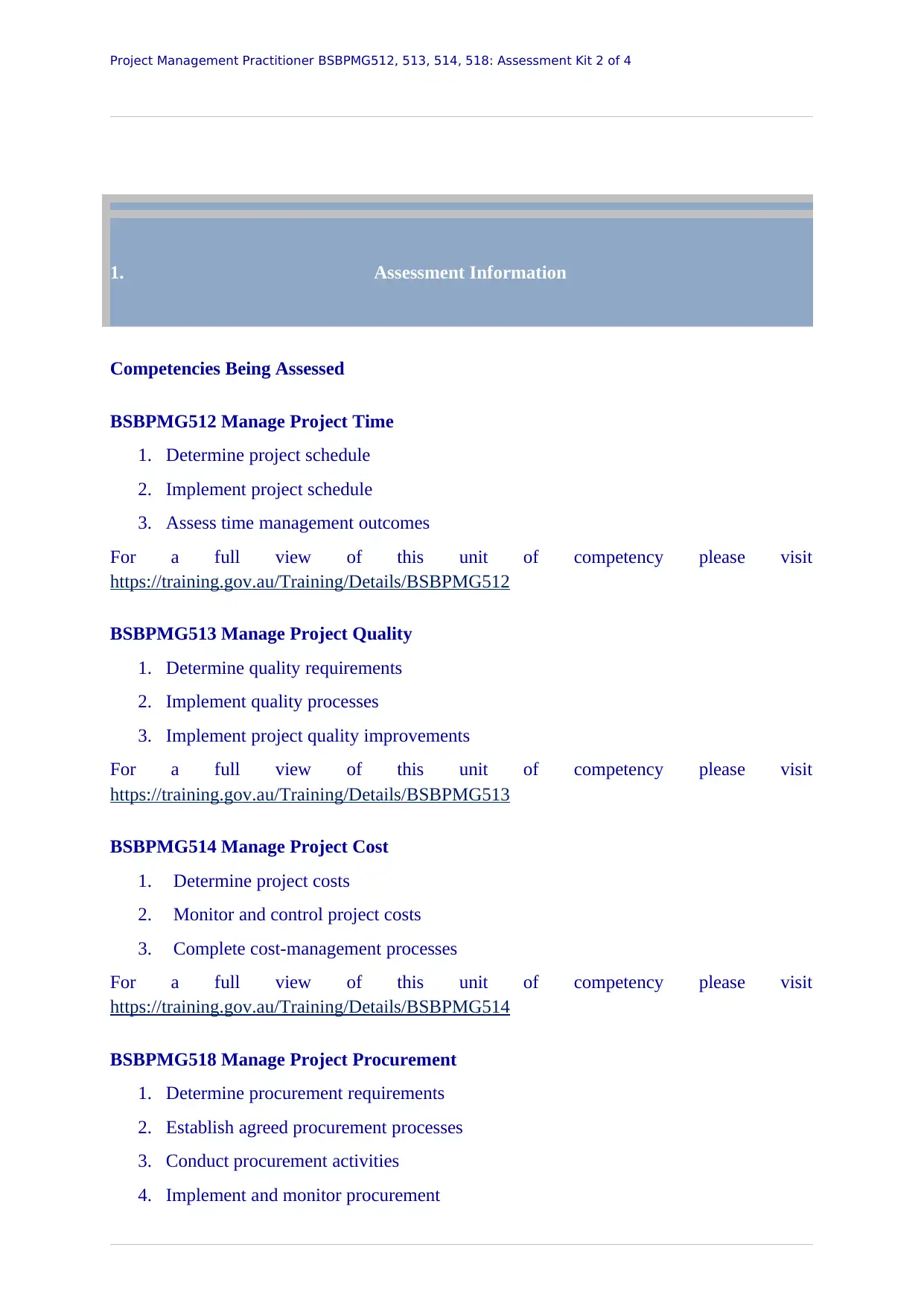
Project Management Practitioner BSBPMG512, 513, 514, 518: Assessment Kit 2 of 4
1. Assessment Information
Competencies Being Assessed
BSBPMG512 Manage Project Time
1. Determine project schedule
2. Implement project schedule
3. Assess time management outcomes
For a full view of this unit of competency please visit
https://training.gov.au/Training/Details/BSBPMG512
BSBPMG513 Manage Project Quality
1. Determine quality requirements
2. Implement quality processes
3. Implement project quality improvements
For a full view of this unit of competency please visit
https://training.gov.au/Training/Details/BSBPMG513
BSBPMG514 Manage Project Cost
1. Determine project costs
2. Monitor and control project costs
3. Complete cost-management processes
For a full view of this unit of competency please visit
https://training.gov.au/Training/Details/BSBPMG514
BSBPMG518 Manage Project Procurement
1. Determine procurement requirements
2. Establish agreed procurement processes
3. Conduct procurement activities
4. Implement and monitor procurement
1. Assessment Information
Competencies Being Assessed
BSBPMG512 Manage Project Time
1. Determine project schedule
2. Implement project schedule
3. Assess time management outcomes
For a full view of this unit of competency please visit
https://training.gov.au/Training/Details/BSBPMG512
BSBPMG513 Manage Project Quality
1. Determine quality requirements
2. Implement quality processes
3. Implement project quality improvements
For a full view of this unit of competency please visit
https://training.gov.au/Training/Details/BSBPMG513
BSBPMG514 Manage Project Cost
1. Determine project costs
2. Monitor and control project costs
3. Complete cost-management processes
For a full view of this unit of competency please visit
https://training.gov.au/Training/Details/BSBPMG514
BSBPMG518 Manage Project Procurement
1. Determine procurement requirements
2. Establish agreed procurement processes
3. Conduct procurement activities
4. Implement and monitor procurement
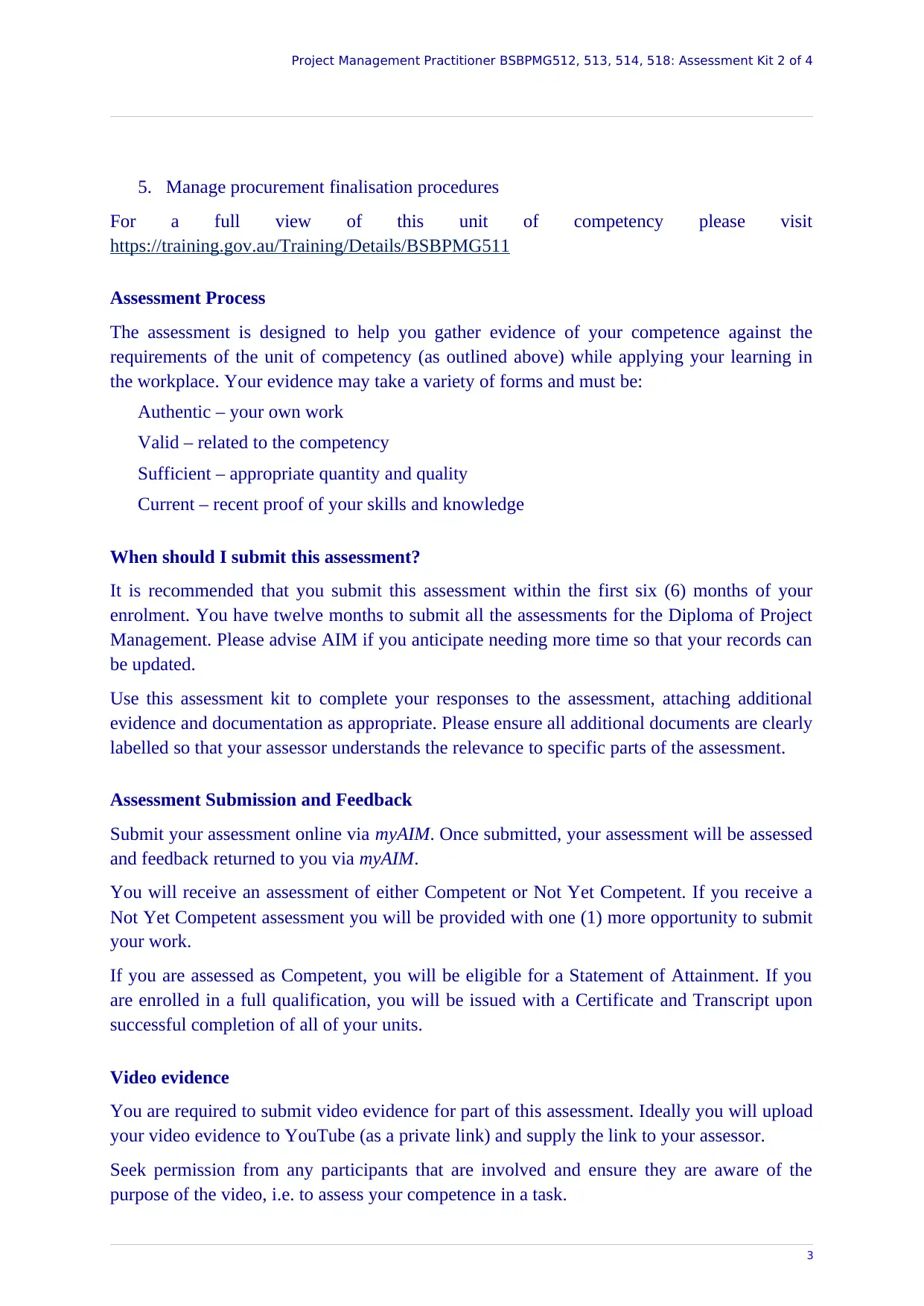
Project Management Practitioner BSBPMG512, 513, 514, 518: Assessment Kit 2 of 4
5. Manage procurement finalisation procedures
For a full view of this unit of competency please visit
https://training.gov.au/Training/Details/BSBPMG511
Assessment Process
The assessment is designed to help you gather evidence of your competence against the
requirements of the unit of competency (as outlined above) while applying your learning in
the workplace. Your evidence may take a variety of forms and must be:
Authentic – your own work
Valid – related to the competency
Sufficient – appropriate quantity and quality
Current – recent proof of your skills and knowledge
When should I submit this assessment?
It is recommended that you submit this assessment within the first six (6) months of your
enrolment. You have twelve months to submit all the assessments for the Diploma of Project
Management. Please advise AIM if you anticipate needing more time so that your records can
be updated.
Use this assessment kit to complete your responses to the assessment, attaching additional
evidence and documentation as appropriate. Please ensure all additional documents are clearly
labelled so that your assessor understands the relevance to specific parts of the assessment.
Assessment Submission and Feedback
Submit your assessment online via myAIM. Once submitted, your assessment will be assessed
and feedback returned to you via myAIM.
You will receive an assessment of either Competent or Not Yet Competent. If you receive a
Not Yet Competent assessment you will be provided with one (1) more opportunity to submit
your work.
If you are assessed as Competent, you will be eligible for a Statement of Attainment. If you
are enrolled in a full qualification, you will be issued with a Certificate and Transcript upon
successful completion of all of your units.
Video evidence
You are required to submit video evidence for part of this assessment. Ideally you will upload
your video evidence to YouTube (as a private link) and supply the link to your assessor.
Seek permission from any participants that are involved and ensure they are aware of the
purpose of the video, i.e. to assess your competence in a task.
3
5. Manage procurement finalisation procedures
For a full view of this unit of competency please visit
https://training.gov.au/Training/Details/BSBPMG511
Assessment Process
The assessment is designed to help you gather evidence of your competence against the
requirements of the unit of competency (as outlined above) while applying your learning in
the workplace. Your evidence may take a variety of forms and must be:
Authentic – your own work
Valid – related to the competency
Sufficient – appropriate quantity and quality
Current – recent proof of your skills and knowledge
When should I submit this assessment?
It is recommended that you submit this assessment within the first six (6) months of your
enrolment. You have twelve months to submit all the assessments for the Diploma of Project
Management. Please advise AIM if you anticipate needing more time so that your records can
be updated.
Use this assessment kit to complete your responses to the assessment, attaching additional
evidence and documentation as appropriate. Please ensure all additional documents are clearly
labelled so that your assessor understands the relevance to specific parts of the assessment.
Assessment Submission and Feedback
Submit your assessment online via myAIM. Once submitted, your assessment will be assessed
and feedback returned to you via myAIM.
You will receive an assessment of either Competent or Not Yet Competent. If you receive a
Not Yet Competent assessment you will be provided with one (1) more opportunity to submit
your work.
If you are assessed as Competent, you will be eligible for a Statement of Attainment. If you
are enrolled in a full qualification, you will be issued with a Certificate and Transcript upon
successful completion of all of your units.
Video evidence
You are required to submit video evidence for part of this assessment. Ideally you will upload
your video evidence to YouTube (as a private link) and supply the link to your assessor.
Seek permission from any participants that are involved and ensure they are aware of the
purpose of the video, i.e. to assess your competence in a task.
3
⊘ This is a preview!⊘
Do you want full access?
Subscribe today to unlock all pages.

Trusted by 1+ million students worldwide
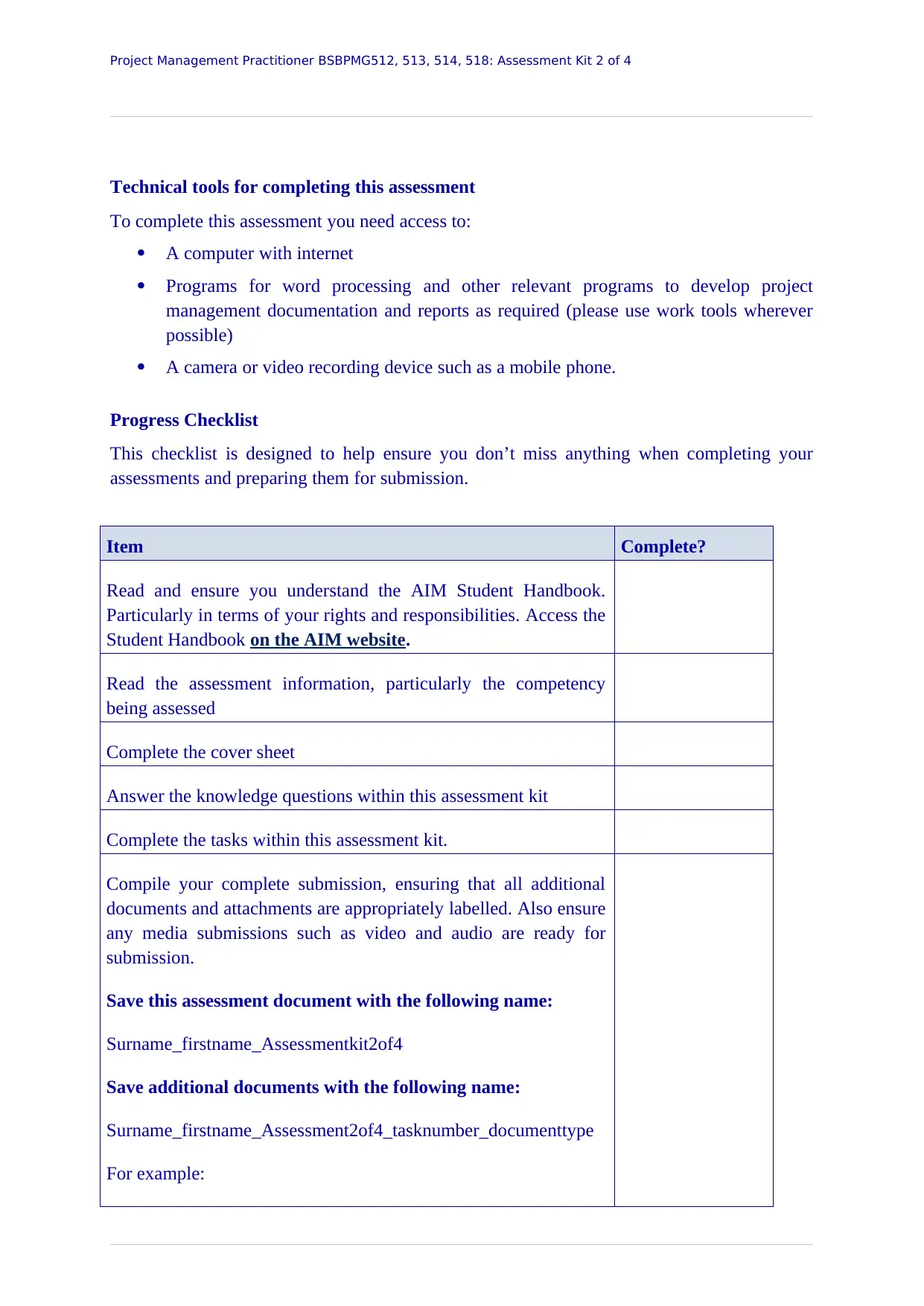
Project Management Practitioner BSBPMG512, 513, 514, 518: Assessment Kit 2 of 4
Technical tools for completing this assessment
To complete this assessment you need access to:
A computer with internet
Programs for word processing and other relevant programs to develop project
management documentation and reports as required (please use work tools wherever
possible)
A camera or video recording device such as a mobile phone.
Progress Checklist
This checklist is designed to help ensure you don’t miss anything when completing your
assessments and preparing them for submission.
Item Complete?
Read and ensure you understand the AIM Student Handbook.
Particularly in terms of your rights and responsibilities. Access the
Student Handbook on the AIM website.
Read the assessment information, particularly the competency
being assessed
Complete the cover sheet
Answer the knowledge questions within this assessment kit
Complete the tasks within this assessment kit.
Compile your complete submission, ensuring that all additional
documents and attachments are appropriately labelled. Also ensure
any media submissions such as video and audio are ready for
submission.
Save this assessment document with the following name:
Surname_firstname_Assessmentkit2of4
Save additional documents with the following name:
Surname_firstname_Assessment2of4_tasknumber_documenttype
For example:
Technical tools for completing this assessment
To complete this assessment you need access to:
A computer with internet
Programs for word processing and other relevant programs to develop project
management documentation and reports as required (please use work tools wherever
possible)
A camera or video recording device such as a mobile phone.
Progress Checklist
This checklist is designed to help ensure you don’t miss anything when completing your
assessments and preparing them for submission.
Item Complete?
Read and ensure you understand the AIM Student Handbook.
Particularly in terms of your rights and responsibilities. Access the
Student Handbook on the AIM website.
Read the assessment information, particularly the competency
being assessed
Complete the cover sheet
Answer the knowledge questions within this assessment kit
Complete the tasks within this assessment kit.
Compile your complete submission, ensuring that all additional
documents and attachments are appropriately labelled. Also ensure
any media submissions such as video and audio are ready for
submission.
Save this assessment document with the following name:
Surname_firstname_Assessmentkit2of4
Save additional documents with the following name:
Surname_firstname_Assessment2of4_tasknumber_documenttype
For example:
Paraphrase This Document
Need a fresh take? Get an instant paraphrase of this document with our AI Paraphraser
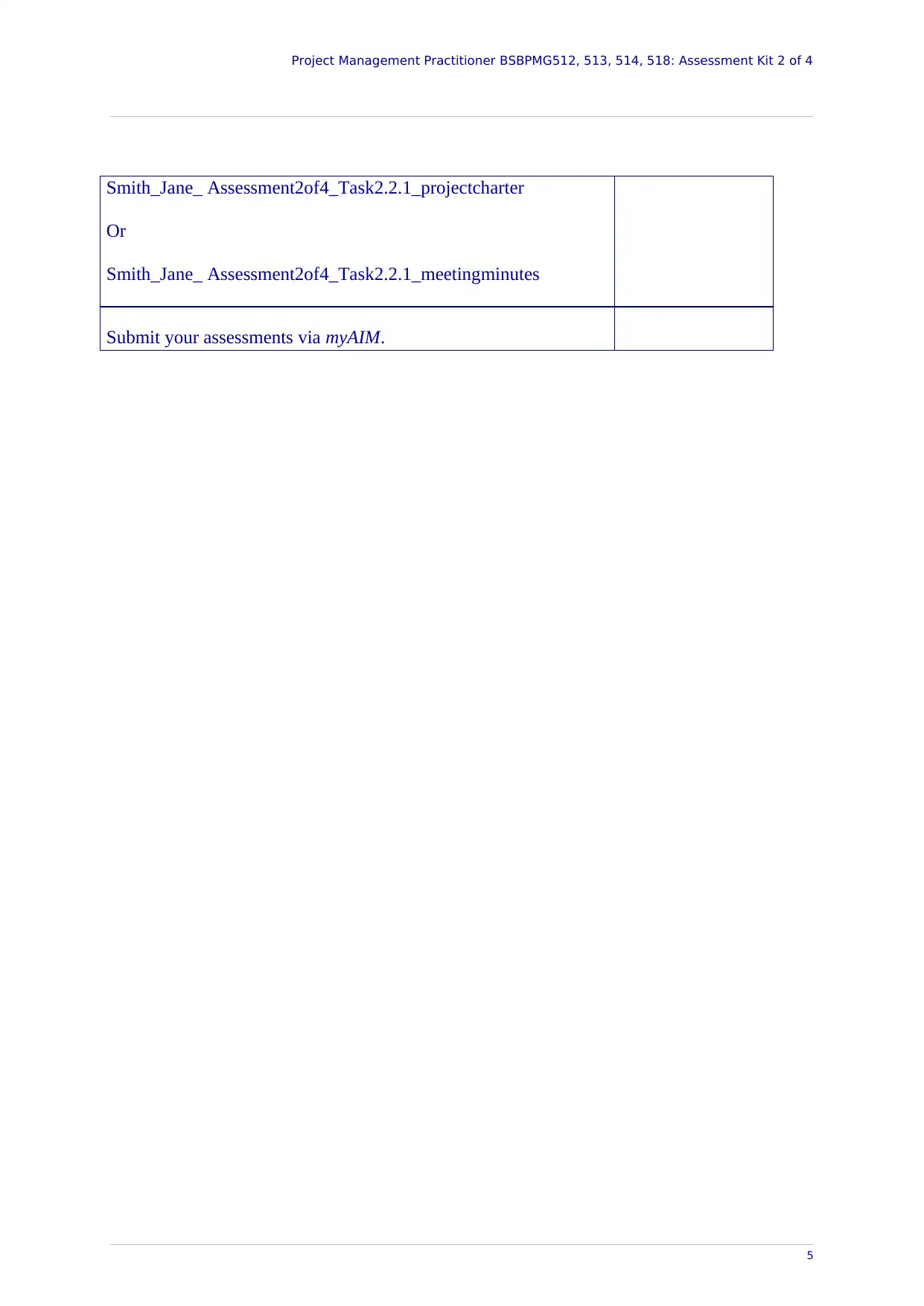
Project Management Practitioner BSBPMG512, 513, 514, 518: Assessment Kit 2 of 4
Smith_Jane_ Assessment2of4_Task2.2.1_projectcharter
Or
Smith_Jane_ Assessment2of4_Task2.2.1_meetingminutes
Submit your assessments via myAIM.
5
Smith_Jane_ Assessment2of4_Task2.2.1_projectcharter
Or
Smith_Jane_ Assessment2of4_Task2.2.1_meetingminutes
Submit your assessments via myAIM.
5
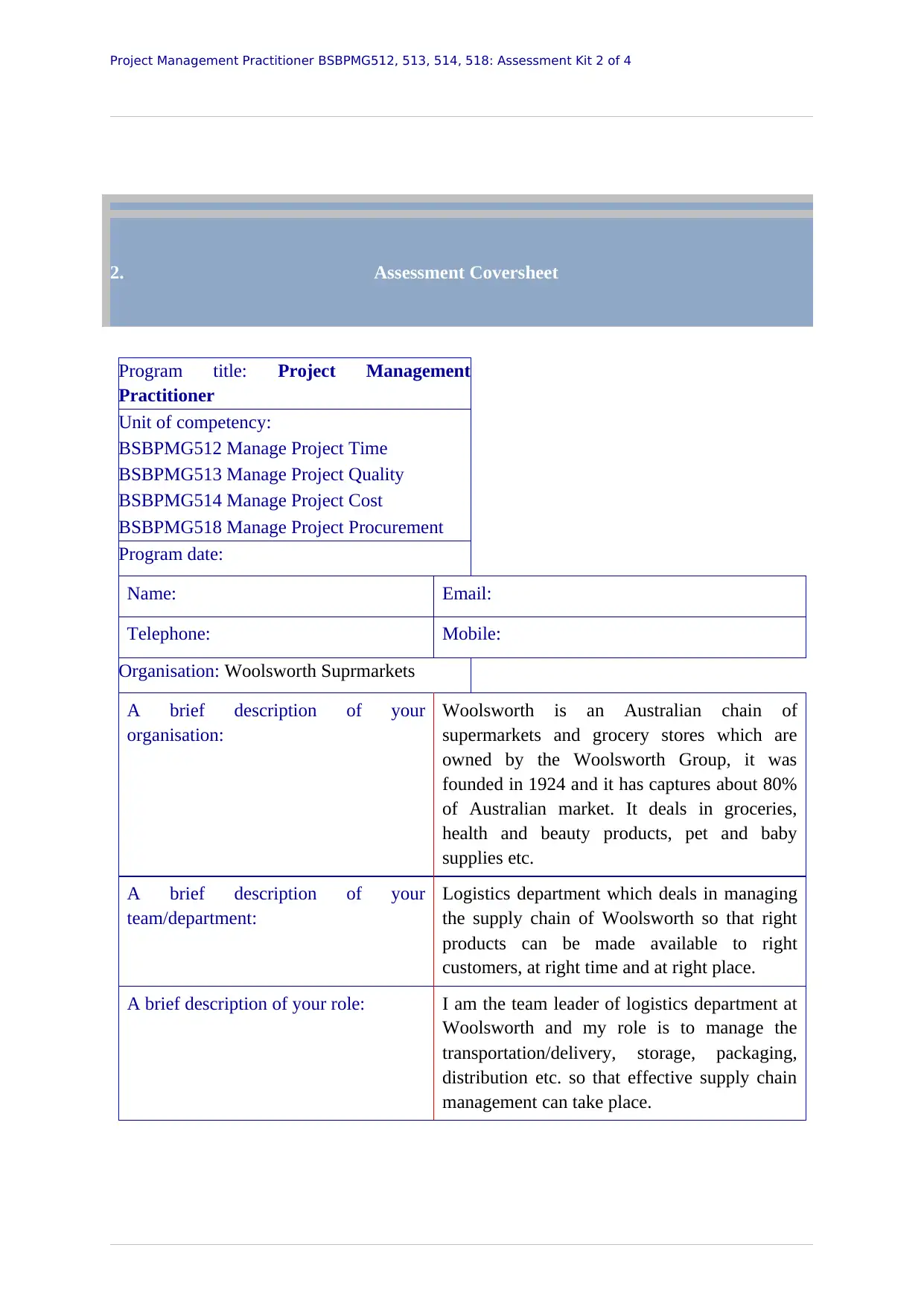
Project Management Practitioner BSBPMG512, 513, 514, 518: Assessment Kit 2 of 4
2. Assessment Coversheet
Program title: Project Management
Practitioner
Unit of competency:
BSBPMG512 Manage Project Time
BSBPMG513 Manage Project Quality
BSBPMG514 Manage Project Cost
BSBPMG518 Manage Project Procurement
Program date:
Name: Email:
Telephone: Mobile:
Organisation: Woolsworth Suprmarkets
A brief description of your
organisation:
Woolsworth is an Australian chain of
supermarkets and grocery stores which are
owned by the Woolsworth Group, it was
founded in 1924 and it has captures about 80%
of Australian market. It deals in groceries,
health and beauty products, pet and baby
supplies etc.
A brief description of your
team/department:
Logistics department which deals in managing
the supply chain of Woolsworth so that right
products can be made available to right
customers, at right time and at right place.
A brief description of your role: I am the team leader of logistics department at
Woolsworth and my role is to manage the
transportation/delivery, storage, packaging,
distribution etc. so that effective supply chain
management can take place.
2. Assessment Coversheet
Program title: Project Management
Practitioner
Unit of competency:
BSBPMG512 Manage Project Time
BSBPMG513 Manage Project Quality
BSBPMG514 Manage Project Cost
BSBPMG518 Manage Project Procurement
Program date:
Name: Email:
Telephone: Mobile:
Organisation: Woolsworth Suprmarkets
A brief description of your
organisation:
Woolsworth is an Australian chain of
supermarkets and grocery stores which are
owned by the Woolsworth Group, it was
founded in 1924 and it has captures about 80%
of Australian market. It deals in groceries,
health and beauty products, pet and baby
supplies etc.
A brief description of your
team/department:
Logistics department which deals in managing
the supply chain of Woolsworth so that right
products can be made available to right
customers, at right time and at right place.
A brief description of your role: I am the team leader of logistics department at
Woolsworth and my role is to manage the
transportation/delivery, storage, packaging,
distribution etc. so that effective supply chain
management can take place.
⊘ This is a preview!⊘
Do you want full access?
Subscribe today to unlock all pages.

Trusted by 1+ million students worldwide
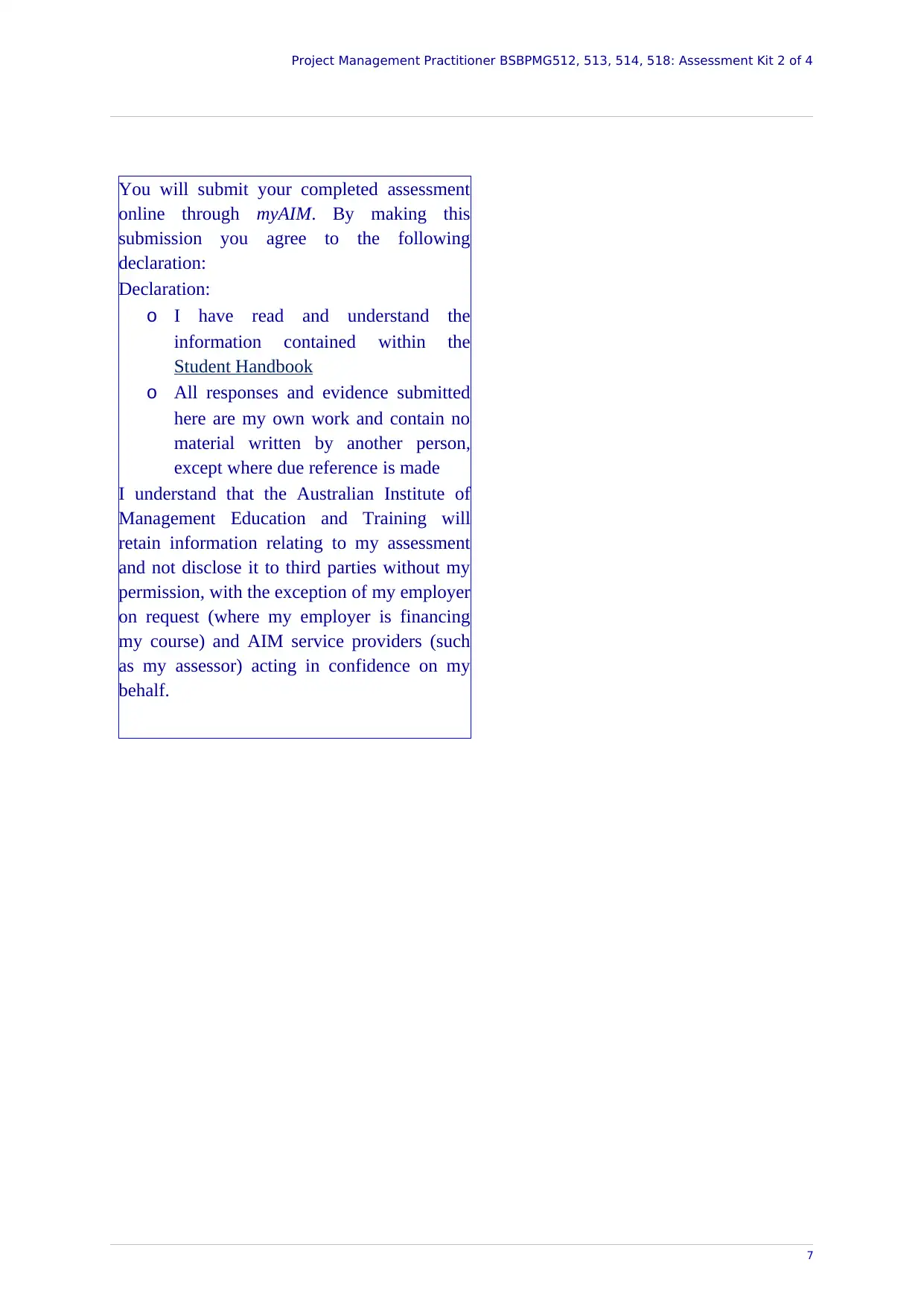
Project Management Practitioner BSBPMG512, 513, 514, 518: Assessment Kit 2 of 4
You will submit your completed assessment
online through myAIM. By making this
submission you agree to the following
declaration:
Declaration:
o I have read and understand the
information contained within the
Student Handbook
o All responses and evidence submitted
here are my own work and contain no
material written by another person,
except where due reference is made
I understand that the Australian Institute of
Management Education and Training will
retain information relating to my assessment
and not disclose it to third parties without my
permission, with the exception of my employer
on request (where my employer is financing
my course) and AIM service providers (such
as my assessor) acting in confidence on my
behalf.
7
You will submit your completed assessment
online through myAIM. By making this
submission you agree to the following
declaration:
Declaration:
o I have read and understand the
information contained within the
Student Handbook
o All responses and evidence submitted
here are my own work and contain no
material written by another person,
except where due reference is made
I understand that the Australian Institute of
Management Education and Training will
retain information relating to my assessment
and not disclose it to third parties without my
permission, with the exception of my employer
on request (where my employer is financing
my course) and AIM service providers (such
as my assessor) acting in confidence on my
behalf.
7
Paraphrase This Document
Need a fresh take? Get an instant paraphrase of this document with our AI Paraphraser
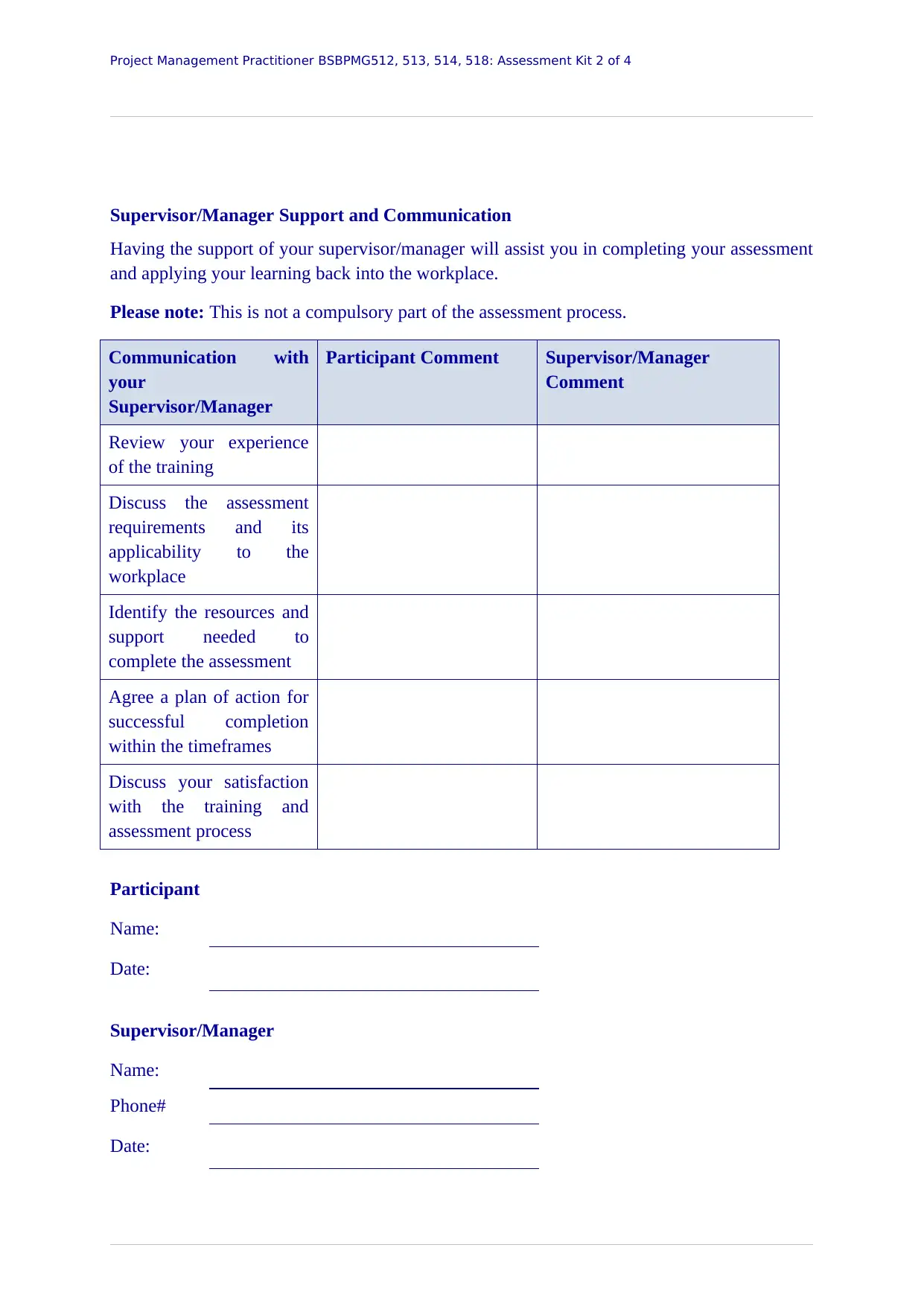
Project Management Practitioner BSBPMG512, 513, 514, 518: Assessment Kit 2 of 4
Supervisor/Manager Support and Communication
Having the support of your supervisor/manager will assist you in completing your assessment
and applying your learning back into the workplace.
Please note: This is not a compulsory part of the assessment process.
Communication with
your
Supervisor/Manager
Participant Comment Supervisor/Manager
Comment
Review your experience
of the training
Discuss the assessment
requirements and its
applicability to the
workplace
Identify the resources and
support needed to
complete the assessment
Agree a plan of action for
successful completion
within the timeframes
Discuss your satisfaction
with the training and
assessment process
Participant
Name:
Date:
Supervisor/Manager
Name:
Phone#
Date:
Supervisor/Manager Support and Communication
Having the support of your supervisor/manager will assist you in completing your assessment
and applying your learning back into the workplace.
Please note: This is not a compulsory part of the assessment process.
Communication with
your
Supervisor/Manager
Participant Comment Supervisor/Manager
Comment
Review your experience
of the training
Discuss the assessment
requirements and its
applicability to the
workplace
Identify the resources and
support needed to
complete the assessment
Agree a plan of action for
successful completion
within the timeframes
Discuss your satisfaction
with the training and
assessment process
Participant
Name:
Date:
Supervisor/Manager
Name:
Phone#
Date:
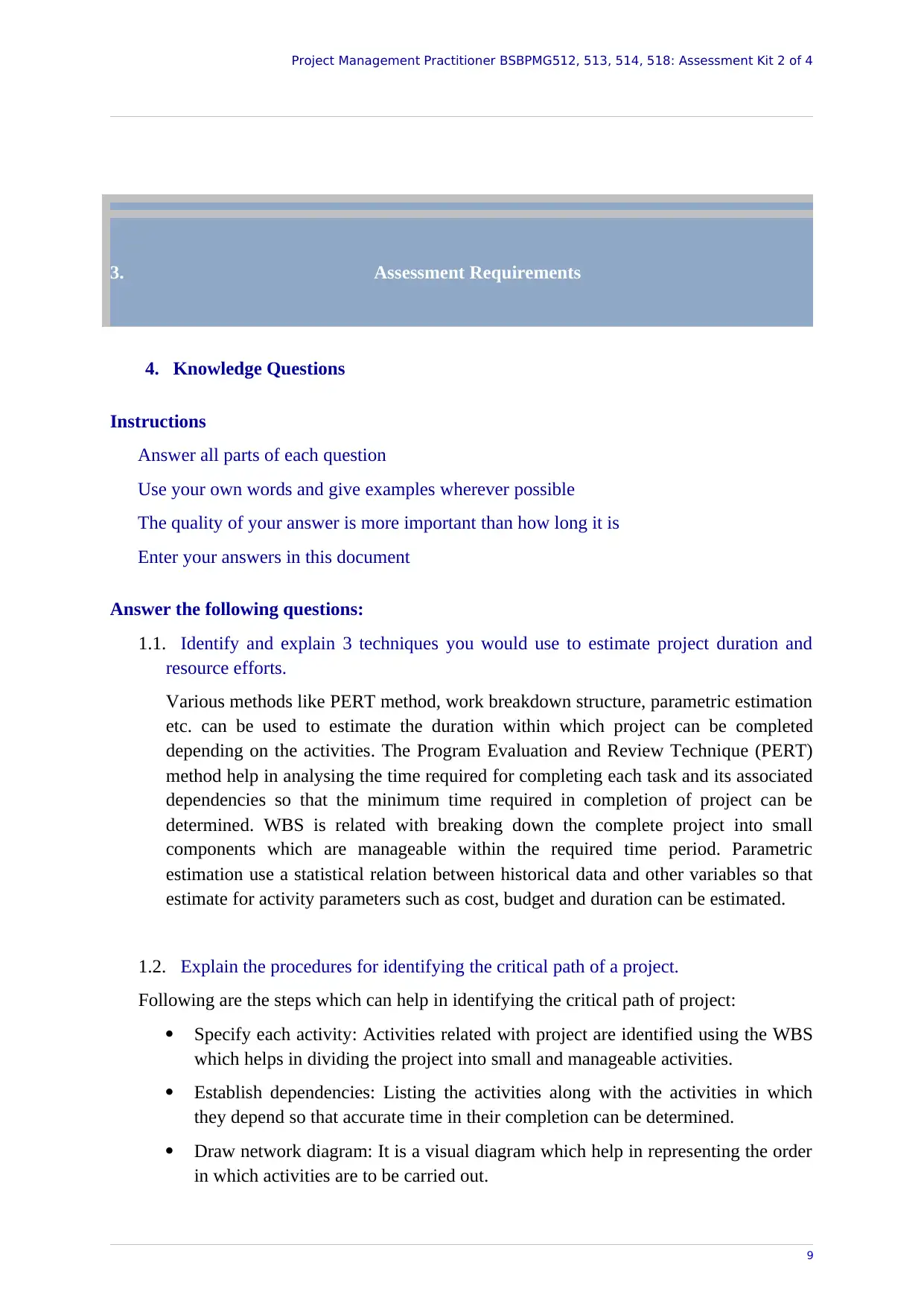
Project Management Practitioner BSBPMG512, 513, 514, 518: Assessment Kit 2 of 4
3. Assessment Requirements
4. Knowledge Questions
Instructions
Answer all parts of each question
Use your own words and give examples wherever possible
The quality of your answer is more important than how long it is
Enter your answers in this document
Answer the following questions:
1.1. Identify and explain 3 techniques you would use to estimate project duration and
resource efforts.
Various methods like PERT method, work breakdown structure, parametric estimation
etc. can be used to estimate the duration within which project can be completed
depending on the activities. The Program Evaluation and Review Technique (PERT)
method help in analysing the time required for completing each task and its associated
dependencies so that the minimum time required in completion of project can be
determined. WBS is related with breaking down the complete project into small
components which are manageable within the required time period. Parametric
estimation use a statistical relation between historical data and other variables so that
estimate for activity parameters such as cost, budget and duration can be estimated.
1.2. Explain the procedures for identifying the critical path of a project.
Following are the steps which can help in identifying the critical path of project:
Specify each activity: Activities related with project are identified using the WBS
which helps in dividing the project into small and manageable activities.
Establish dependencies: Listing the activities along with the activities in which
they depend so that accurate time in their completion can be determined.
Draw network diagram: It is a visual diagram which help in representing the order
in which activities are to be carried out.
9
3. Assessment Requirements
4. Knowledge Questions
Instructions
Answer all parts of each question
Use your own words and give examples wherever possible
The quality of your answer is more important than how long it is
Enter your answers in this document
Answer the following questions:
1.1. Identify and explain 3 techniques you would use to estimate project duration and
resource efforts.
Various methods like PERT method, work breakdown structure, parametric estimation
etc. can be used to estimate the duration within which project can be completed
depending on the activities. The Program Evaluation and Review Technique (PERT)
method help in analysing the time required for completing each task and its associated
dependencies so that the minimum time required in completion of project can be
determined. WBS is related with breaking down the complete project into small
components which are manageable within the required time period. Parametric
estimation use a statistical relation between historical data and other variables so that
estimate for activity parameters such as cost, budget and duration can be estimated.
1.2. Explain the procedures for identifying the critical path of a project.
Following are the steps which can help in identifying the critical path of project:
Specify each activity: Activities related with project are identified using the WBS
which helps in dividing the project into small and manageable activities.
Establish dependencies: Listing the activities along with the activities in which
they depend so that accurate time in their completion can be determined.
Draw network diagram: It is a visual diagram which help in representing the order
in which activities are to be carried out.
9
⊘ This is a preview!⊘
Do you want full access?
Subscribe today to unlock all pages.

Trusted by 1+ million students worldwide
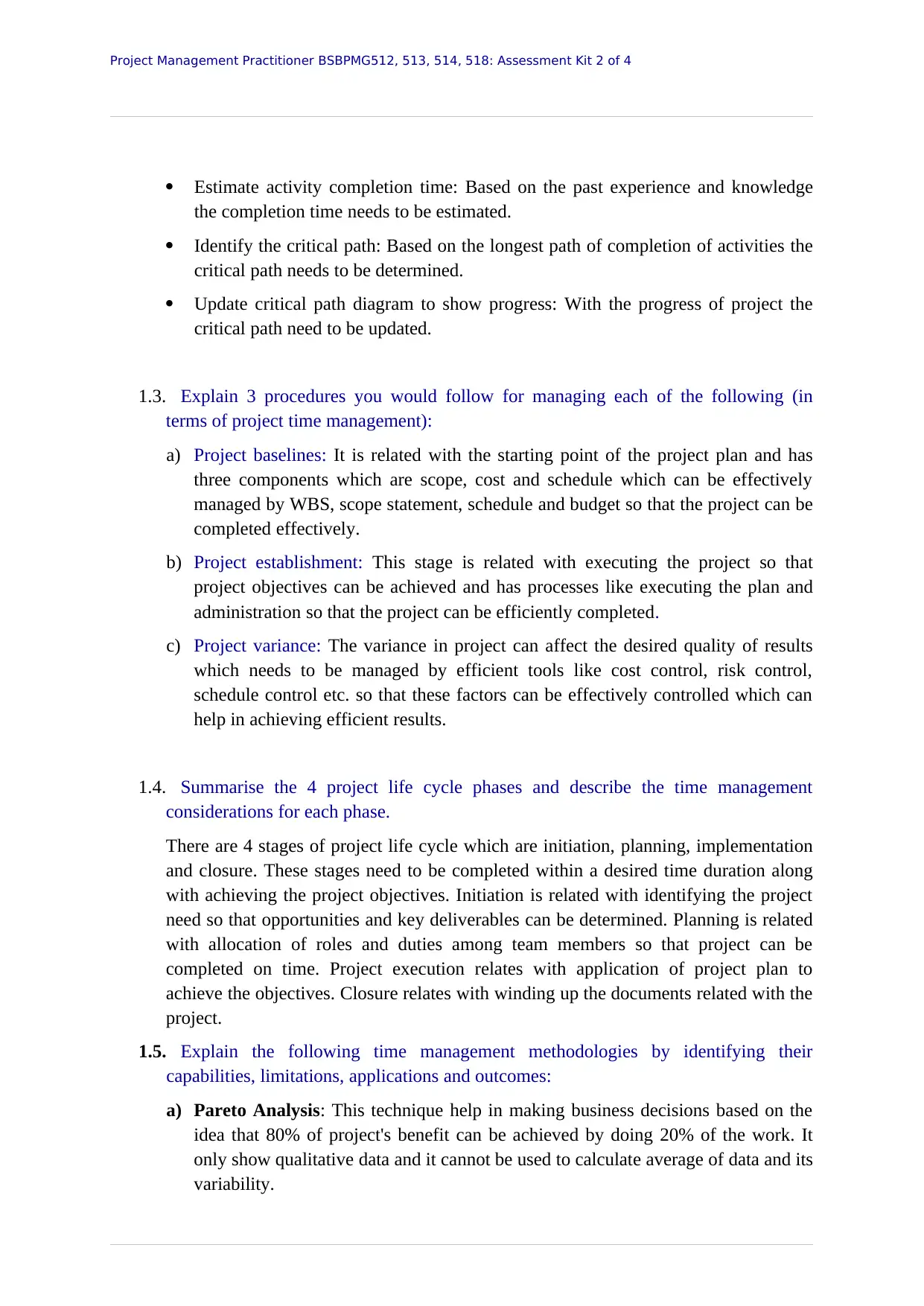
Project Management Practitioner BSBPMG512, 513, 514, 518: Assessment Kit 2 of 4
Estimate activity completion time: Based on the past experience and knowledge
the completion time needs to be estimated.
Identify the critical path: Based on the longest path of completion of activities the
critical path needs to be determined.
Update critical path diagram to show progress: With the progress of project the
critical path need to be updated.
1.3. Explain 3 procedures you would follow for managing each of the following (in
terms of project time management):
a) Project baselines: It is related with the starting point of the project plan and has
three components which are scope, cost and schedule which can be effectively
managed by WBS, scope statement, schedule and budget so that the project can be
completed effectively.
b) Project establishment: This stage is related with executing the project so that
project objectives can be achieved and has processes like executing the plan and
administration so that the project can be efficiently completed.
c) Project variance: The variance in project can affect the desired quality of results
which needs to be managed by efficient tools like cost control, risk control,
schedule control etc. so that these factors can be effectively controlled which can
help in achieving efficient results.
1.4. Summarise the 4 project life cycle phases and describe the time management
considerations for each phase.
There are 4 stages of project life cycle which are initiation, planning, implementation
and closure. These stages need to be completed within a desired time duration along
with achieving the project objectives. Initiation is related with identifying the project
need so that opportunities and key deliverables can be determined. Planning is related
with allocation of roles and duties among team members so that project can be
completed on time. Project execution relates with application of project plan to
achieve the objectives. Closure relates with winding up the documents related with the
project.
1.5. Explain the following time management methodologies by identifying their
capabilities, limitations, applications and outcomes:
a) Pareto Analysis: This technique help in making business decisions based on the
idea that 80% of project's benefit can be achieved by doing 20% of the work. It
only show qualitative data and it cannot be used to calculate average of data and its
variability.
Estimate activity completion time: Based on the past experience and knowledge
the completion time needs to be estimated.
Identify the critical path: Based on the longest path of completion of activities the
critical path needs to be determined.
Update critical path diagram to show progress: With the progress of project the
critical path need to be updated.
1.3. Explain 3 procedures you would follow for managing each of the following (in
terms of project time management):
a) Project baselines: It is related with the starting point of the project plan and has
three components which are scope, cost and schedule which can be effectively
managed by WBS, scope statement, schedule and budget so that the project can be
completed effectively.
b) Project establishment: This stage is related with executing the project so that
project objectives can be achieved and has processes like executing the plan and
administration so that the project can be efficiently completed.
c) Project variance: The variance in project can affect the desired quality of results
which needs to be managed by efficient tools like cost control, risk control,
schedule control etc. so that these factors can be effectively controlled which can
help in achieving efficient results.
1.4. Summarise the 4 project life cycle phases and describe the time management
considerations for each phase.
There are 4 stages of project life cycle which are initiation, planning, implementation
and closure. These stages need to be completed within a desired time duration along
with achieving the project objectives. Initiation is related with identifying the project
need so that opportunities and key deliverables can be determined. Planning is related
with allocation of roles and duties among team members so that project can be
completed on time. Project execution relates with application of project plan to
achieve the objectives. Closure relates with winding up the documents related with the
project.
1.5. Explain the following time management methodologies by identifying their
capabilities, limitations, applications and outcomes:
a) Pareto Analysis: This technique help in making business decisions based on the
idea that 80% of project's benefit can be achieved by doing 20% of the work. It
only show qualitative data and it cannot be used to calculate average of data and its
variability.
Paraphrase This Document
Need a fresh take? Get an instant paraphrase of this document with our AI Paraphraser
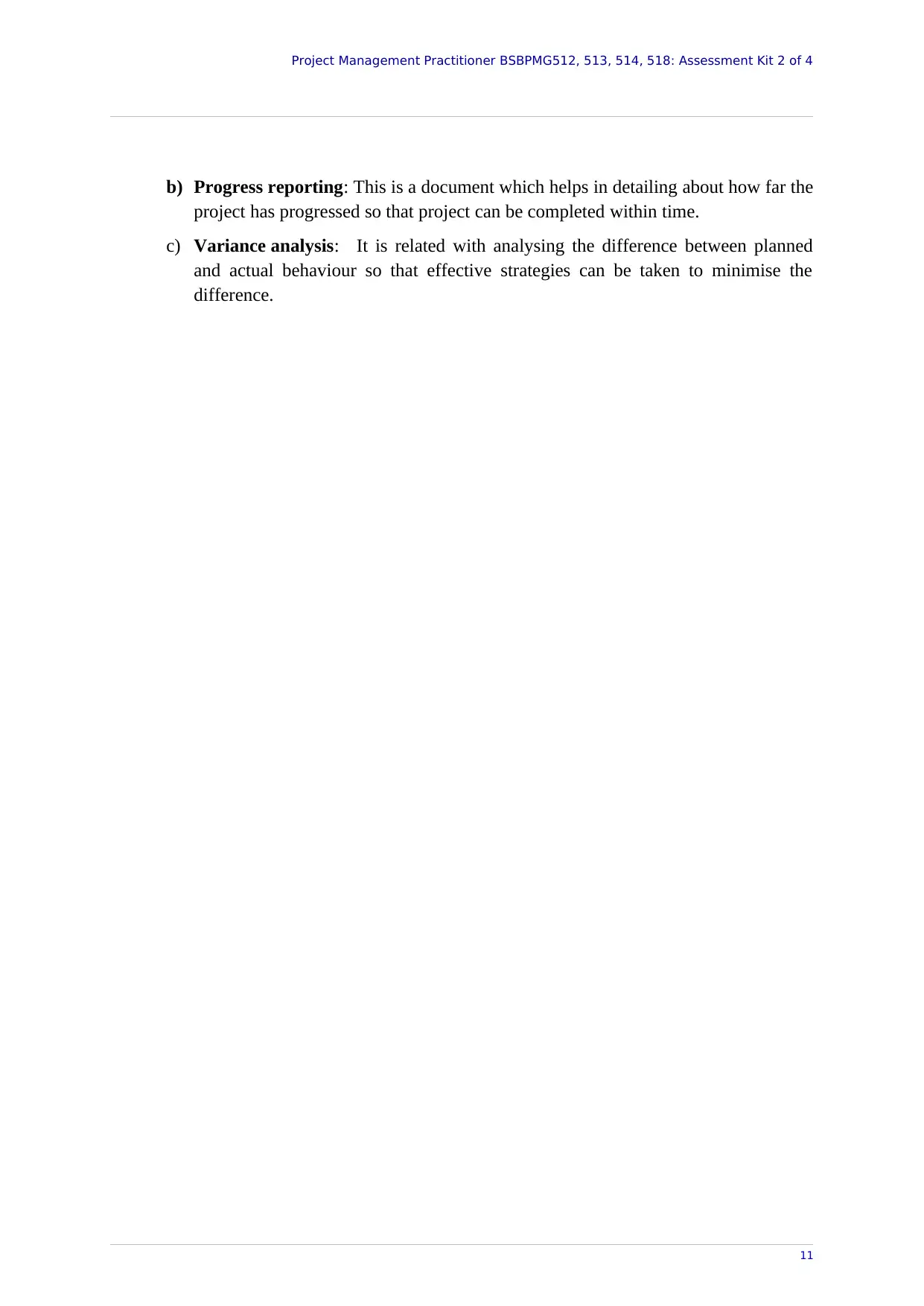
Project Management Practitioner BSBPMG512, 513, 514, 518: Assessment Kit 2 of 4
b) Progress reporting: This is a document which helps in detailing about how far the
project has progressed so that project can be completed within time.
c) Variance analysis: It is related with analysing the difference between planned
and actual behaviour so that effective strategies can be taken to minimise the
difference.
11
b) Progress reporting: This is a document which helps in detailing about how far the
project has progressed so that project can be completed within time.
c) Variance analysis: It is related with analysing the difference between planned
and actual behaviour so that effective strategies can be taken to minimise the
difference.
11
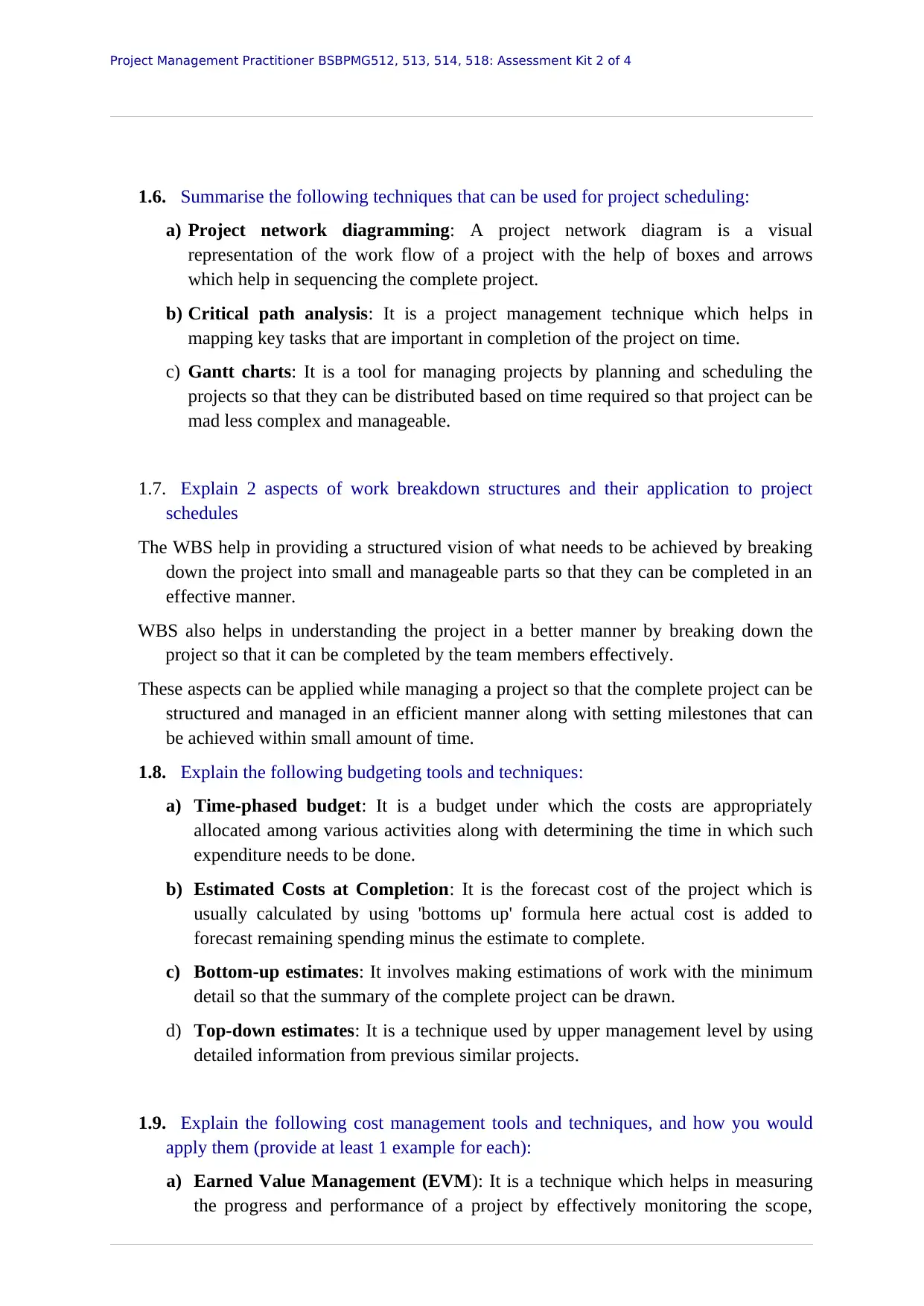
Project Management Practitioner BSBPMG512, 513, 514, 518: Assessment Kit 2 of 4
1.6. Summarise the following techniques that can be used for project scheduling:
a) Project network diagramming: A project network diagram is a visual
representation of the work flow of a project with the help of boxes and arrows
which help in sequencing the complete project.
b) Critical path analysis: It is a project management technique which helps in
mapping key tasks that are important in completion of the project on time.
c) Gantt charts: It is a tool for managing projects by planning and scheduling the
projects so that they can be distributed based on time required so that project can be
mad less complex and manageable.
1.7. Explain 2 aspects of work breakdown structures and their application to project
schedules
The WBS help in providing a structured vision of what needs to be achieved by breaking
down the project into small and manageable parts so that they can be completed in an
effective manner.
WBS also helps in understanding the project in a better manner by breaking down the
project so that it can be completed by the team members effectively.
These aspects can be applied while managing a project so that the complete project can be
structured and managed in an efficient manner along with setting milestones that can
be achieved within small amount of time.
1.8. Explain the following budgeting tools and techniques:
a) Time-phased budget: It is a budget under which the costs are appropriately
allocated among various activities along with determining the time in which such
expenditure needs to be done.
b) Estimated Costs at Completion: It is the forecast cost of the project which is
usually calculated by using 'bottoms up' formula here actual cost is added to
forecast remaining spending minus the estimate to complete.
c) Bottom-up estimates: It involves making estimations of work with the minimum
detail so that the summary of the complete project can be drawn.
d) Top-down estimates: It is a technique used by upper management level by using
detailed information from previous similar projects.
1.9. Explain the following cost management tools and techniques, and how you would
apply them (provide at least 1 example for each):
a) Earned Value Management (EVM): It is a technique which helps in measuring
the progress and performance of a project by effectively monitoring the scope,
1.6. Summarise the following techniques that can be used for project scheduling:
a) Project network diagramming: A project network diagram is a visual
representation of the work flow of a project with the help of boxes and arrows
which help in sequencing the complete project.
b) Critical path analysis: It is a project management technique which helps in
mapping key tasks that are important in completion of the project on time.
c) Gantt charts: It is a tool for managing projects by planning and scheduling the
projects so that they can be distributed based on time required so that project can be
mad less complex and manageable.
1.7. Explain 2 aspects of work breakdown structures and their application to project
schedules
The WBS help in providing a structured vision of what needs to be achieved by breaking
down the project into small and manageable parts so that they can be completed in an
effective manner.
WBS also helps in understanding the project in a better manner by breaking down the
project so that it can be completed by the team members effectively.
These aspects can be applied while managing a project so that the complete project can be
structured and managed in an efficient manner along with setting milestones that can
be achieved within small amount of time.
1.8. Explain the following budgeting tools and techniques:
a) Time-phased budget: It is a budget under which the costs are appropriately
allocated among various activities along with determining the time in which such
expenditure needs to be done.
b) Estimated Costs at Completion: It is the forecast cost of the project which is
usually calculated by using 'bottoms up' formula here actual cost is added to
forecast remaining spending minus the estimate to complete.
c) Bottom-up estimates: It involves making estimations of work with the minimum
detail so that the summary of the complete project can be drawn.
d) Top-down estimates: It is a technique used by upper management level by using
detailed information from previous similar projects.
1.9. Explain the following cost management tools and techniques, and how you would
apply them (provide at least 1 example for each):
a) Earned Value Management (EVM): It is a technique which helps in measuring
the progress and performance of a project by effectively monitoring the scope,
⊘ This is a preview!⊘
Do you want full access?
Subscribe today to unlock all pages.

Trusted by 1+ million students worldwide
1 out of 37
Related Documents
Your All-in-One AI-Powered Toolkit for Academic Success.
+13062052269
info@desklib.com
Available 24*7 on WhatsApp / Email
![[object Object]](/_next/static/media/star-bottom.7253800d.svg)
Unlock your academic potential
Copyright © 2020–2025 A2Z Services. All Rights Reserved. Developed and managed by ZUCOL.





